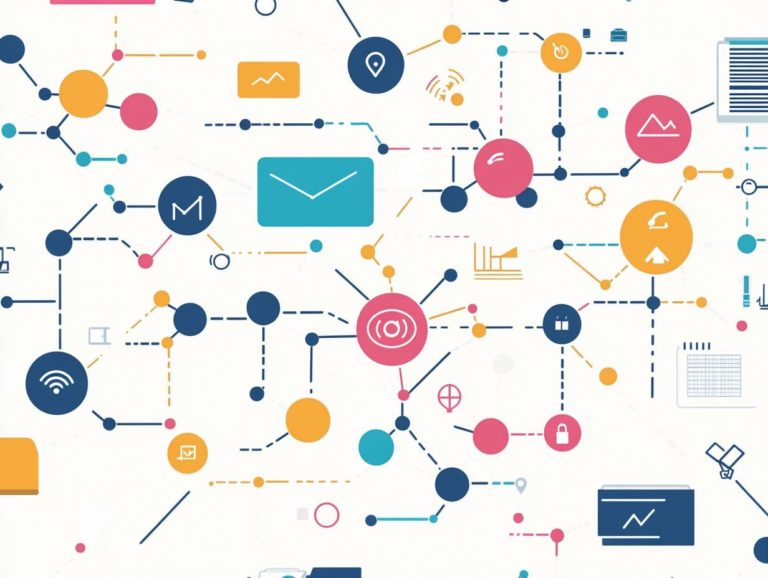how to prioritize tasks in projects?
In today s fast-paced work environment, mastering effective task prioritization is crucial for achieving your project goals and maximizing productivity.
Whether you re juggling multiple deadlines or steering a team, your ability to identify and prioritize tasks can truly make all the difference.
This article delves into various prioritization methods, including the ABC Analysis and the Eisenhower Matrix. It also considers essential factors like urgency, available resources, and overall impact.
You will also find practical tips that help streamline your approach and keep you focused.
Get ready to take your task management skills to new heights!
Contents
- Key Takeaways:
- Understanding Task Prioritization
- Methods for Prioritizing Tasks
- Factors to Consider when Prioritizing Tasks
- Tips for Effective Task Prioritization
- Frequently Asked Questions
- 1. What is the importance of prioritizing tasks in projects?
- 2. How Can I Determine Which Tasks Should Be Prioritized in a Project?
- 3. Is It Better to Prioritize Tasks Based on Urgency or Importance?
- 4. How Can I Effectively Communicate the Priorities of Tasks to My Team?
- 5. Can Task Priorities Change During a Project?
- 6. How Can I Stay Organized and Focused When Managing Multiple Tasks in a Project?
Key Takeaways:

- Prioritizing tasks is essential for project success.
- Key methods include ABC analysis and the Eisenhower Matrix.
- Always consider urgency and resources when prioritizing.
- Regularly review your priorities and maintain clear communication with your team.
Understanding Task Prioritization
Task prioritization is vital for effective project management. It helps you identify the most important and urgent tasks, ensuring that your team focuses on the right activities to meet project deadlines.
By leveraging tools like Teamwork.com and employing frameworks such as the Eisenhower Matrix, you can significantly enhance your workload management. This approach boosts productivity and fosters seamless communication, ensuring your team remains aligned with overarching business goals.
Definition and Importance
Task prioritization is the art of categorizing tasks based on their urgency and importance within project management. This practice streamlines workflows and plays a pivotal role in achieving your business goals.
By effectively identifying critical priorities, you can direct your team s efforts toward high-impact assignments, ensuring that resources are allocated where they matter most.
Using time management strategies, such as the Eisenhower Matrix, gives you the power to distinguish between what is urgent and what is significant, ultimately enhancing your productivity.
In this way, task prioritization becomes an essential tool for navigating the complexities of project execution, leading to successful outcomes and fostering a cohesive team effort.
Methods for Prioritizing Tasks
You have a range of effective methods at your disposal for prioritizing tasks. Techniques such as the Eisenhower Matrix, ABC Analysis, and the MoSCoW Method empower teams to manage their workload with precision and reach project milestones efficiently.
By employing these strategies, you can enhance productivity and ensure that the most critical tasks receive the attention they deserve.
ABC Analysis
ABC Analysis is a powerful method for prioritizing tasks by categorizing them into three distinct groups: A (high priority), B (medium priority), and C (low priority). This enables you to manage your workload effectively.
By distinguishing between what s crucial and what s less critical, you can allocate your resources more efficiently and ensure that the most impactful work takes precedence.
For example, high-priority tasks might include:
- Looming deadlines for key projects.
Medium-priority tasks could involve:
- Regular team meetings.
- Progress updates.
Low-priority tasks, such as routine administrative duties, can be scheduled during quieter periods.
This structured approach fosters accountability among team members and enhances communication, as everyone is clear about their responsibilities and the overarching project timeline.
Consequently, you can maintain focus and drive toward objectives with greater clarity.
Eisenhower Matrix

The Eisenhower Matrix is a powerful tool for prioritizing tasks. It helps you distinguish between what s urgent and what s truly important, improving your time management skills.
By categorizing tasks into four distinct quadrants, the matrix offers a clear perspective on what demands your immediate attention versus what aligns with your long-term objectives.
The first quadrant contains tasks that are both urgent and important, requiring your prompt action. The second quadrant includes important but not urgent tasks, encouraging proactive planning.
The third quadrant features tasks that are urgent but lack importance these are prime candidates for delegation, allowing you to reclaim valuable time.
The fourth quadrant encompasses tasks that are neither urgent nor important, which are typically suitable for minimization or even elimination.
This structured methodology boosts your productivity and fosters focused, meaningful work, enabling you to concentrate on tasks that matter while avoiding superficial progress.
MoSCoW Method
The MoSCoW Method is your go-to prioritization technique that helps you categorize tasks into four clear categories: Must have, Should have, Could have, and Won’t have. This clarity is essential for defining project scope and understanding task dependencies.
By adopting this structured approach, you can streamline workloads and enhance your team’s overall efficiency. It encourages open communication about what’s essential versus what’s negotiable, allowing your team to focus on tasks that truly drive project outcomes.
As priorities shift or challenges arise, the flexibility built into the MoSCoW Method empowers you to make necessary adjustments without losing momentum. This ensures more strategic resource allocation, allowing you to invest time and skills in high-impact areas while keeping a clear vision of your project goals.
Factors to Consider when Prioritizing Tasks
When prioritizing your tasks, evaluate factors like urgency, importance, available resources, and overall impact on your project goals.
This thoughtful approach ensures effective workload management and maximizes your efforts.
Urgency and Importance
Understanding the distinction between urgency and importance is crucial for effective task prioritization, directly influencing how you identify critical priorities. Urgent tasks demand immediate attention like responding to a last-minute client request or tackling a technical glitch significantly enhancing your time management skills.
In contrast, important tasks such as strategic planning for a long-term project or nurturing client relationships require thoughtful consideration over time rather than a quick reaction. By categorizing your daily responsibilities into these two groups, you can develop a more structured approach to productivity.
For example, scheduling regular check-ins for important projects while reserving time for urgent matters can help you achieve a balanced workload, minimizing stress and maximizing outcomes.
Available Resources
Evaluating the resources at your disposal is crucial for task prioritization, as it directly impacts your team’s capacity and aligns with the overarching scope of the project. Understanding these resources enables informed decisions, balancing high-priority tasks with available manpower.
When you effectively implement workload optimization, you streamline operations and ensure deadlines are met without compromising quality. This allows your team to navigate complexities and chaos more efficiently, facilitating progress toward key project milestones.
Adopting this proactive approach to resource management enhances productivity and empowers you and your team to focus on critical tasks that propel the project forward.
Take control of your tasks and apply these prioritization methods in your daily routines for better task management!
Impact on Project Goals

Task prioritization significantly impacts your project goals. It shapes the project’s value and aligns it with your business objectives.
A structured approach to prioritizing tasks streamlines your efforts. This ensures that every action you take resonates with your business aims.
This alignment makes resource allocation easier, allowing you to focus your time and budget on the most critical activities.
Accountability increases as stakeholders track progress. They can see how individual contributions support the broader goals.
A well-prioritized framework fosters a shared understanding. This reduces confusion and boosts overall project success.
Tips for Effective Task Prioritization
To master task prioritization, set clear goals and deadlines. Open communication with your team is essential for regularly reassessing your priorities.
This boosts productivity and creates a teamwork atmosphere focused on shared objectives.
Setting Clear Goals and Deadlines
Clear goals and deadlines anchor your team’s efforts. This promotes accountability across all roles.
Specific, measurable objectives clarify expectations and create a roadmap to success. For example, if your marketing team wants to boost social media engagement, aim for a 20% increase in post shares within three months.
This strategy drives focused efforts and provides a tangible metric for progress, keeping you aligned with broader business objectives.
Communicating with Team Members
Effective communication is crucial for prioritizing tasks and fostering collaboration. Engaging in open discussions about responsibilities makes aligning on immediate tasks easier.
Utilizing regular check-in meetings and project management tools can enhance this dialogue. A team that holds weekly stand-ups can swiftly tackle urgent tasks and minimize confusion.
Enhanced communication builds a shared understanding of priorities, empowering everyone to contribute effectively.
Reassessing Priorities Regularly
Regularly reassessing priorities helps you stay flexible in response to changing project needs. This approach identifies emerging challenges and allows for efficient resource allocation.
By scheduling regular check-ins, you can discuss current workloads and adjust focus as needed. Digital project management tools provide visual representations of priorities that are easy to update.
Emphasizing adaptability empowers team members to suggest changes, driving productivity and helping meet project objectives accurately.
Frequently Asked Questions

1. What is the importance of prioritizing tasks in projects?
Prioritizing tasks is crucial for project success. It helps manage time and resources efficiently, ensures important tasks are completed first, and keeps focus on project goals.
2. How Can I Determine Which Tasks Should Be Prioritized in a Project?
To determine which tasks should be prioritized, consider their urgency and impact on project goals. Identify time-sensitive tasks that are critical for success and those that rely on others.
3. Is It Better to Prioritize Tasks Based on Urgency or Importance?
Both urgency and importance are vital in task prioritization. Start by focusing on tasks that are both urgent and important, followed by important but less urgent tasks.
4. How Can I Effectively Communicate the Priorities of Tasks to My Team?
Communicate task priorities by understanding project goals and deadlines. Use a project management tool to assign tasks, set deadlines, and provide regular updates. Encourage open communication to address concerns or conflicts.
5. Can Task Priorities Change During a Project?
Yes, task priorities can change. Make it a habit to review priorities regularly to keep your project on track, especially as goals evolve or new urgent tasks arise!
6. How Can I Stay Organized and Focused When Managing Multiple Tasks in a Project?
Stay organized by creating a prioritized to-do list and breaking larger tasks into smaller ones. Delegate when necessary and use time management techniques like the Pomodoro Technique to maintain focus.






